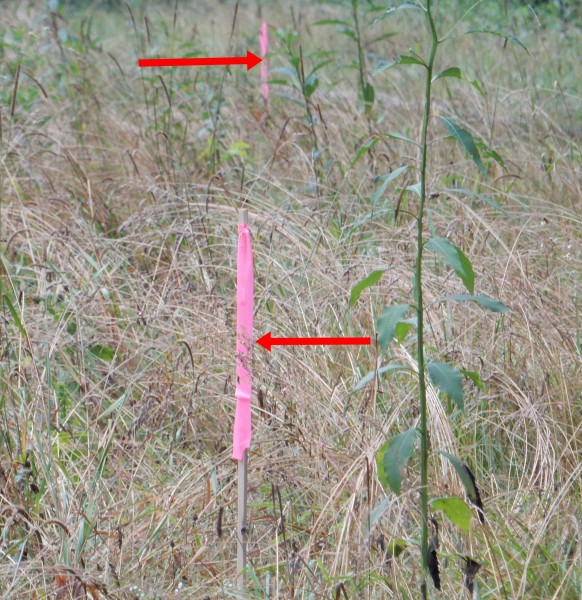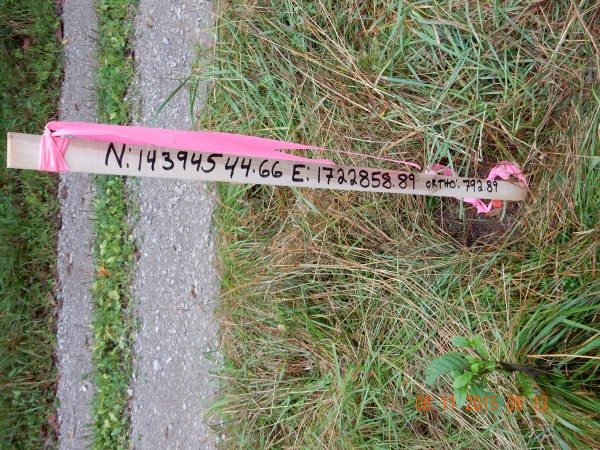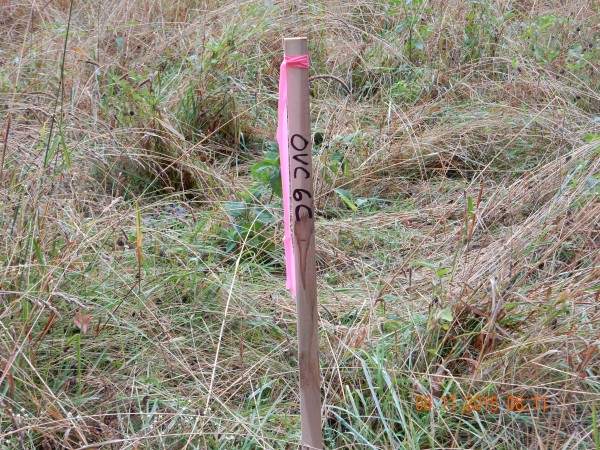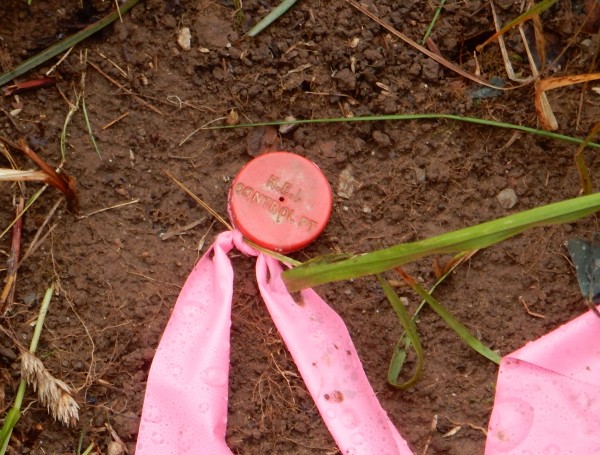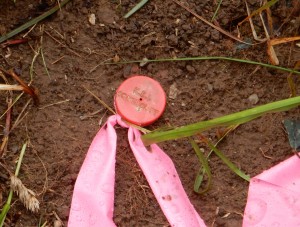Below is Push for Pipelines – Part 3. Read Part 1 here and Part 2 here.
A Word On Surveyors
Most folks can relate to the work and responsibility of bookkeepers or certified public accountants. (CPAs). They measure and keep track of money. And their balance sheets and ledgers actually have to, well, balance. And they do so exactly. Think of surveyors as the CPAs of the land world. When they go up one of our big hills and down the other side, the will keep track of every inch. They will not tolerate losing a few inches here and few there. They truly are professionals. They are exact. They will measure and document everything with precision. And the ones I have spoken with are usually courteous and respectful, too. They are a credit to their profession. They are aware of the eminent domain threat and their surveying success depends on treating landowners with respect. They are good at what they do. But, only when they are given the correct route to survey to start with.
Surveyor Stakes and Flags
In my regular travels throughout the natural gas fields here, countless signs of surveyors are visible. Indeed, throughout an active shale gas field, the first signs of the pending invasion or expansion of the already conquered territory are the simple markings of stakes, flags, and pins. Many months or even a year or two before the chain saw fells the first tree or the first dozer blade cuts the dirt at a well pad location, the surveyors, on behalf of their corporate tactical command staff, have “marked their target.” The surveyors have a map and they are drawing bull’s eyes on my property, on your property. We are the targets, marked by the signs of the surveyors.
Even with a reported slowdown in drilling activities due to a glut of gas on the market, proposed pipeline installations are keeping surveyors busy. Once you focus on them, assorted types of stakes and ribbons and markings are hard to miss along our roads. Here in the active gas field, as I drive our narrow roads trying to squeeze by all the over-sized gas trucks, I usually notice many of the newer surveyor’s flags and the normal wooden stakes. They are used to mark out future well pads, access roads, compressor station locations and, more recently, pipelines. And even more pipelines. And now even bigger pipelines.
Although I try to notice them along the roadways, to be honest, it has gotten difficult to keep track of all of the signs of surveyors. Their flags can be seen every few miles and usually it is hard at first to identify why they are there. And since they are never taken down when no longer needed, the old ones sometimes hide the new ones.
Learn More: Read Surveyor Signs and Symbols
Even if sometimes I am not sure exactly what a stake and flag might indicate, when one shows up very unexpectedly in what is essentially my front yard, it is absolutely impossible to not see it. It is upsetting. And that is what happened last summer.
Recall (from Part 2) that the EQT land man first visited us in February 2014. Until August 2015, we enjoyed our peace, quiet and relative isolation here where we live, with no more surveyor stake intrusions.But then one summer day, I returned home to our 79-acre farm, which lies in a narrow valley in Wetzel County. T
One day in August, I returned home to find brightly colored flags in our hay field. With all the rain the previous month, we had not been able to get our hay cut. So the hay was tall, and had some weeds, but the colored flags were highly visible because the hay had been driven down where the surveyors had parked their trucks, in my field alongside my access road.
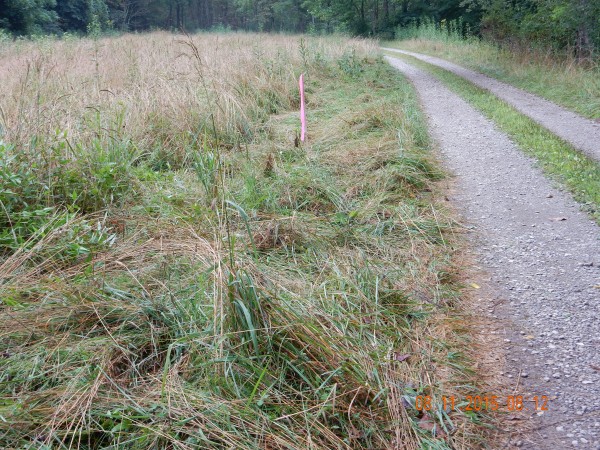
To call the surveyors’ actions trespassing might not be legally defensible, yet. But in my opinion, this was trespassing. The stakes were near a public road, but make no mistake here, the pins and stakes and flags were on my property and I wanted answers now! Incidents like this, whether intentional or accidental, are what have given the gas companies a reputation as bad neighbors. There were surveyor’s stakes, flags, and control point pins at two locations. My hay was driven down. And, I had no idea what all this meant. I had had no communication from anyone at EQT in more than 18 months. But on the brighter side, I was very fortunate that these guys were carrying measuring equipment and not chain saws. Trees might have been cut — it’s been known to happen.
The photo below shows the two sets of wooden stakes, maybe 75 feet apart, with flags and steel rebar pins with caps on them. Both stakes were near the gravel lane which is a public right of way. The stakes were clearly on my property.
The inscriptions and details on one of the stakes were similar to the other, with just minor differences in the measurements. The photo below is a close-up of one of the stakes in my hay field.
The markings on the other side of the stake identified it as locating the Ohio Valley Connector (OVC) pipeline; see photo below. The identifying numbers on the stake are unique, and the amount of detail on the stake is special, since this is for a very specific type of location called a control point.
EQT’s OVC pipeline, if approved by FERC and constructed, will be a 30-inch diameter pipeline. It seemed that somehow, without informing me, or asking specific permission to be on my property that EQT had again changed its corporate mind and is now planning on fragmenting my habitat, intent on running its big pipeline right through my hay field and through the stream on my property. I got a problem.
Upon closer inspection, it was obvious that these two stakes and flags had control point steel pins driven into the ground below them. This can be seen here:
The close up picture below makes it clear that this is a surveyor control point for the OVC pipeline. A closer at the bottom of the stake reveals that this is the actual marking pin. The photo shows the detail of the plastic identifying cap on the top of the steel pin which is driven into the ground. These control point pins are usually located off to the side of the center-line of the pipeline. But I did not see any other surveyed stakes or markings.
As usual, I documented all this with these detailed pictures in preparation for sending an irate, flaming e-mail to some EQT representative in Pittsburgh, PA. Trespassing, real or perceived is always a sensitive topic. This is especially true since when I had initially allowed the surveyor to come onto on my property (more than 18 months prior), I had not given permission for this. I wanted answers quickly.
So what happened? You’ll find out if you read Push for Pipelines – Part 4, here.
All photos by Bill Hughes.
